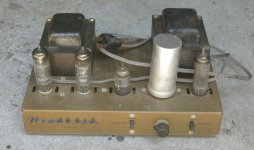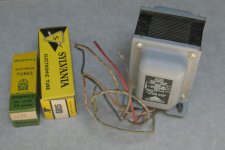Well, I swung by my Dad's house and did some digging in the attic. I've pulled out his Presto turntable as a new project.
This will be more of a restoration than a heavy modification. There are a lot of memories tied up in this. I remember it being in the living room system for years (I remember it from about 1960 to about 1975 when he replaced it with a used Weathers turntable). This is the turntable my sister wore out her mono copy of Rubber Soul on.
Dad made the base out of some scrap pine. The main motor plate is carved out of a piece of about 3/16ths thick scrap iron (there are a few extra holes in it from a previous ussage). The Velvet Touch tonearm is the best feature, and should clean up pretty nicely.
I think I will clean, sand, prime and paint the motor plate. I'll probably sand and stain the case and possibly add some handball feet to give it a bit of suspension.
It will be built up a part of a mono only system for LP's and 78's. I also picked up a small collection of GE cartridges, which should match the tonearm nicely.
Also picked up a nice little Heathkit amp and his old Triplet meter.
Here are the before pictures!
David S.
This will be more of a restoration than a heavy modification. There are a lot of memories tied up in this. I remember it being in the living room system for years (I remember it from about 1960 to about 1975 when he replaced it with a used Weathers turntable). This is the turntable my sister wore out her mono copy of Rubber Soul on.
Dad made the base out of some scrap pine. The main motor plate is carved out of a piece of about 3/16ths thick scrap iron (there are a few extra holes in it from a previous ussage). The Velvet Touch tonearm is the best feature, and should clean up pretty nicely.
I think I will clean, sand, prime and paint the motor plate. I'll probably sand and stain the case and possibly add some handball feet to give it a bit of suspension.
It will be built up a part of a mono only system for LP's and 78's. I also picked up a small collection of GE cartridges, which should match the tonearm nicely.
Also picked up a nice little Heathkit amp and his old Triplet meter.
Here are the before pictures!
David S.
Attachments
-
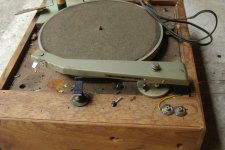 IMGP3937sm.jpg211.9 KB · Views: 395
IMGP3937sm.jpg211.9 KB · Views: 395 -
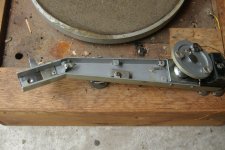 IMGP3938sm.jpg215.7 KB · Views: 347
IMGP3938sm.jpg215.7 KB · Views: 347 -
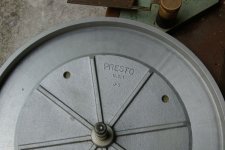 IMGP3939sm.jpg206.6 KB · Views: 332
IMGP3939sm.jpg206.6 KB · Views: 332 -
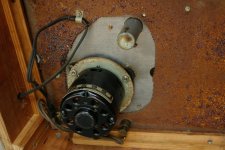 IMGP3942sm.jpg244.7 KB · Views: 221
IMGP3942sm.jpg244.7 KB · Views: 221 -
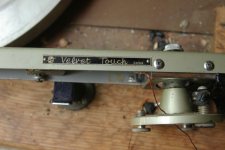 IMGP3941sm.jpg153.5 KB · Views: 321
IMGP3941sm.jpg153.5 KB · Views: 321 -
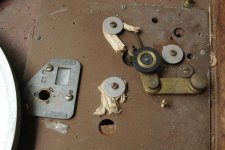 IMGP3940sm.jpg209.8 KB · Views: 319
IMGP3940sm.jpg209.8 KB · Views: 319 -
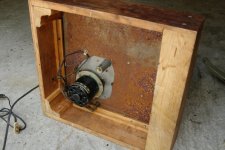 IMGP3943sm.jpg218.9 KB · Views: 209
IMGP3943sm.jpg218.9 KB · Views: 209 -
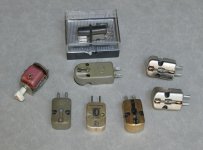 IMGP3945sm.jpg185.4 KB · Views: 227
IMGP3945sm.jpg185.4 KB · Views: 227 -
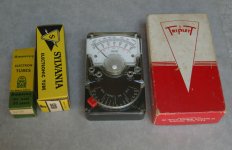 IMGP3947sm.jpg177.5 KB · Views: 225
IMGP3947sm.jpg177.5 KB · Views: 225
I think I'll stick with mono and use it to play my oldest LPs. I like that the "turnover" cartridges wil allow easy switching from "microgroove" to "standard' (78 rpm).
Tonearm is not low mass and the counterweight is not adjustable. You add chunks of lead to the front to get it to balance. I may cut out some of the back weight, as it seems overbalanced to the rear.
David S.
Tonearm is not low mass and the counterweight is not adjustable. You add chunks of lead to the front to get it to balance. I may cut out some of the back weight, as it seems overbalanced to the rear.
David S.
Did you ever have one of those projects that you started in earnest and then put down for a while?
Okay, 11 years later and I've finally made some progress on Dad's Presto turntable.
He had made the case from scraps and miscellaneous. The top plate seemed to be some scrap of 3/16 iron and is heavy! It had random holes from a previous life. I filled them in with epoxy and filled and smoothed the rest of the plate down and painted it in a nice old wine color. The perimeter of the base is made from 2 sides of pine and one side of plywood plus a fat 3" wide piece of timber. Rather than make it too pretty (more so than in its previous life) I just fine sanded it and gave a couple of coatings of oil.
The first design issue was that the tone arm mount would need to be inboard of the right edge of the frame. I looked up the length and angle geometry of the tonearm and it would need to come towards the front a ways to hit that location, further forward than would look right.

The arm has 3 point mounting with height adjusters (not really necessary with a unipivot arm, its going to find its own level, or not!) I want the mounting screws to go about an inch in from their current location.
I cut a piece of pine for the added arm support and got out the old Jorgensen

Same again from another angle.

Willow guards the Snell XA Reference while we wait for the glue to dry.

Here the arm mounting is finished. Note the lead weight on the back. There is a black tray for lead weights underneath the rear of the tonearm. It had a single large lead weight that didn't give the right balance so I took it out and cut it into thirds. Now, since the tone arm has a unipivot, you not only have to set tracking weight but also lateral balance. I tried lots of different combinations and could get the counterbalance weight right but not the lateral balance. This meant the arm would lean left or right. It works out a lot easier to have an external weight and slide it about, as needed, to get the right downforce along with the right lateral balance. Not elegant but who among us didn't have a stack of quarters scotch taped to a tonearm in our youth??
You can also see the nice new cork mat that I got for the turntable.

A couple of shots of the near finished project. About the only thing left is to figure out a tidy way to terminate the wires into phono sockets.


Its on my workbench now. I love using it as it is stable and fuss free. I like having the turnover cartridge and play 45s and 78s and (mono) LPs. (GE variable reluctance cartridge) Being next to me I can play singles one after the other without walking across the room. I had thought of adding suspension, such as handball balls, but it is heavy enough and the bench is steady enough that nothing is going anywhere. Nothing skips.
I should also add the damping oil (it is designed to be viscous damped) but I'm in no hurry. I played with this as a teenager and only succeeded in overdamping it to the point that it took 10 seconds for the arm to drop, causing it to surf from peak to peak on warped records. If the arm were skittering around on 78s I would be more motivated.
That's all for now.
David S.
Okay, 11 years later and I've finally made some progress on Dad's Presto turntable.
He had made the case from scraps and miscellaneous. The top plate seemed to be some scrap of 3/16 iron and is heavy! It had random holes from a previous life. I filled them in with epoxy and filled and smoothed the rest of the plate down and painted it in a nice old wine color. The perimeter of the base is made from 2 sides of pine and one side of plywood plus a fat 3" wide piece of timber. Rather than make it too pretty (more so than in its previous life) I just fine sanded it and gave a couple of coatings of oil.
The first design issue was that the tone arm mount would need to be inboard of the right edge of the frame. I looked up the length and angle geometry of the tonearm and it would need to come towards the front a ways to hit that location, further forward than would look right.
The arm has 3 point mounting with height adjusters (not really necessary with a unipivot arm, its going to find its own level, or not!) I want the mounting screws to go about an inch in from their current location.
I cut a piece of pine for the added arm support and got out the old Jorgensen
Same again from another angle.
Willow guards the Snell XA Reference while we wait for the glue to dry.
Here the arm mounting is finished. Note the lead weight on the back. There is a black tray for lead weights underneath the rear of the tonearm. It had a single large lead weight that didn't give the right balance so I took it out and cut it into thirds. Now, since the tone arm has a unipivot, you not only have to set tracking weight but also lateral balance. I tried lots of different combinations and could get the counterbalance weight right but not the lateral balance. This meant the arm would lean left or right. It works out a lot easier to have an external weight and slide it about, as needed, to get the right downforce along with the right lateral balance. Not elegant but who among us didn't have a stack of quarters scotch taped to a tonearm in our youth??
You can also see the nice new cork mat that I got for the turntable.
A couple of shots of the near finished project. About the only thing left is to figure out a tidy way to terminate the wires into phono sockets.
Its on my workbench now. I love using it as it is stable and fuss free. I like having the turnover cartridge and play 45s and 78s and (mono) LPs. (GE variable reluctance cartridge) Being next to me I can play singles one after the other without walking across the room. I had thought of adding suspension, such as handball balls, but it is heavy enough and the bench is steady enough that nothing is going anywhere. Nothing skips.
I should also add the damping oil (it is designed to be viscous damped) but I'm in no hurry. I played with this as a teenager and only succeeded in overdamping it to the point that it took 10 seconds for the arm to drop, causing it to surf from peak to peak on warped records. If the arm were skittering around on 78s I would be more motivated.
That's all for now.
David S.
By "add the damping" it may not have been clear that I was referring to the tone arm. The arm has a uni-pivot and surrounded by a pair of ball and socket hemispheres. You can add some amount of damping oil between the two spheres and you can also adjust a thumb screw to fine tune the spacing between the two surfaces. Viscosity of oil, percent of filling, and separation of the spheres will determine the amount of damping. I would think you would want just enough to knock down the fundamental resonance (determined by tone arm mass and needle compliance) by a few dB. If you go to far you run into the issues outlined above, that the arm becomes less responsive to tracking the surface.
Here is a nice thread thread about a related Japanese arm (the Velvet Touch was sold under a few other names with minor variation) and shows a cross section that should explain things.
https://www.lencoheaven.net/forum/index.php?topic=32097.0
This was a product from the beginning of the Japanese HiFi industry. It is finely finished and I'm sure my dad ordered out of the Lafayette catalog because it was very affordable. $ll.95 in the 1957 catalog. I think it was about half the price of the Gray 108B that it largely copied.
Here is a nice thread thread about a related Japanese arm (the Velvet Touch was sold under a few other names with minor variation) and shows a cross section that should explain things.
https://www.lencoheaven.net/forum/index.php?topic=32097.0
This was a product from the beginning of the Japanese HiFi industry. It is finely finished and I'm sure my dad ordered out of the Lafayette catalog because it was very affordable. $ll.95 in the 1957 catalog. I think it was about half the price of the Gray 108B that it largely copied.
Last edited:
- Home
- Source & Line
- Analogue Source
- Restoring dad's Presto turntable
